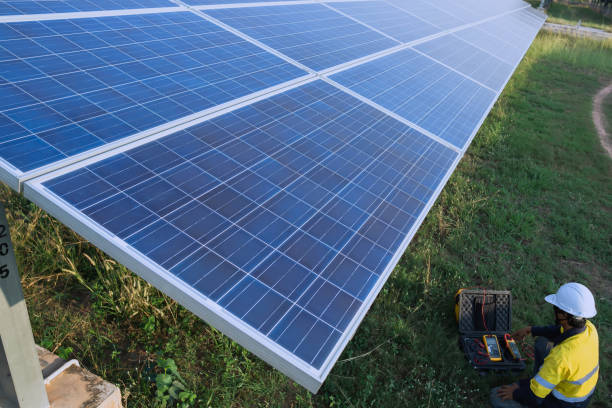Table of Contents
This handbook explores the eco-friendly and cost-effective use of solar power, highlighting its complexity and accessibility in powering homes and businesses.
Understanding Photovoltaic Technology
Photovoltaic (PV) technology converts sunlight into electricity using semiconductors, generating an electric current when photons strike silicon. PV systems are a sustainable alternative to fossil fuels, producing no noise or emissions. The solar cell is the fundamental unit, and solar panels can be used in various applications, from calculators to power stations. Understanding PV technology is crucial for everyday life.
Types of Solar Panels
Solar panels come in various types, each suited for different needs and contexts. The most common types are monocrystalline, polycrystalline, and thin-film panels. Monocrystalline panels, made from a single continuous crystal structure, are recognized for their high efficiency and long lifespan but typically come at a higher cost. Polycrystalline panels, composed of multiple crystal fragments, offer a balance between cost and efficiency, making them popular for residential use. Thin-film panels are lightweight and flexible, suitable for unique applications like integrating into building materials. Each type has its own set of advantages and limitations, so understanding these can help in making informed choices for installing solar power systems.
Installation of Solar Systems
Installing a solar power system involves several crucial steps, from planning and site assessment to the final commissioning and maintenance. Initially, a professional assessment determines the suitability of the location, including roof orientation, shading, and structural capacity. Once the site is deemed appropriate, the next step involves designing the system to optimize energy capture and efficiency. This is followed by the actual installation, which includes mounting the panels, wiring the system, and connecting it to the power grid or battery storage. Maintenance is minimal but essential; regular cleaning and inspections ensure the system functions effectively and lasts longer. Successful installation and upkeep maximize the benefits of a solar power system.
Cost and Financial Incentives
The initial cost of solar panels can be a deterrent, but various financial incentives make it more accessible. Government programs, tax credits, and grants are available in many regions to lower the upfront investment. Additionally, net metering allows homeowners to sell excess power back to the grid, creating an ongoing source of income. Over time, the savings on energy bills can make up for the initial expenditure. Furthermore, the falling cost of PV technology has made solar power increasingly affordable. Understanding the financial landscape, including potential savings and incentives, is crucial for anyone considering switching to solar energy.
Environmental Impacts
Solar power significantly reduces the carbon footprint of energy consumption. Unlike fossil fuels, solar energy production emits no greenhouse gases or pollutants, leading to a cleaner atmosphere. Additionally, solar power reduces reliance on non-renewable resources, thereby conserving them for future generations. However, the production and disposal of solar panels do have some environmental impacts, such as the energy used in manufacturing and the management of waste materials. Advances in recycling technologies and sustainable manufacturing practices are addressing these issues, making solar power an increasingly green option. Understanding the environmental implications helps in making a well-rounded decision when transitioning to solar energy.
Technological Advancements
The field of photovoltaic technology is rapidly evolving, with continuous improvements in efficiency, cost, and application. Innovations such as bifacial solar panels, which capture sunlight from both sides, and perovskite solar cells, known for their high efficiency and low production costs, are paving the way for more effective solar technologies. Energy storage solutions, like advanced batteries, are also evolving, enabling better management of power supply and demand. As technology progresses, the integration of PV systems into everyday life becomes more seamless and beneficial. Staying informed about these advancements can help consumers and businesses alike make the most of their solar investments.
Global Adoption and Case Studies
Countries around the world are increasingly embracing solar power as a key component of their energy strategies. Germany and China lead in solar capacity, while countries like India and the United States are rapidly expanding their installations. Success stories abound, such as rural off-grid solar installations in Africa providing electricity to communities for the first time, and large solar farms supplying significant portions of cities&8217; energy needs. These case studies highlight the versatility and scalability of solar power. By examining global adoption, we can learn valuable lessons and gain insights into the best practices and challenges faced in various regions and contexts.
Future Prospects and Challenges
The future of solar power is incredibly promising, but it is not without challenges. The continued decrease in panel costs and increased efficiency will likely spur even greater adoption. Innovations in energy storage and grid management will also play crucial roles. However, challenges such as land use for large solar farms, the need for better recycling methods for old panels, and policy and regulatory hurdles remain. Addressing these challenges requires coordinated effort among governments, industries, and consumers. Looking ahead, the potential for integrating solar technology with other renewable sources and smart grid systems points to a sustainable and resilient energy future.
Understanding and leveraging photovoltaic technology can lead to significant environmental, economic, and societal benefits. Through ongoing innovation and global collaboration, solar power holds the promise of a cleaner, more sustainable world.

